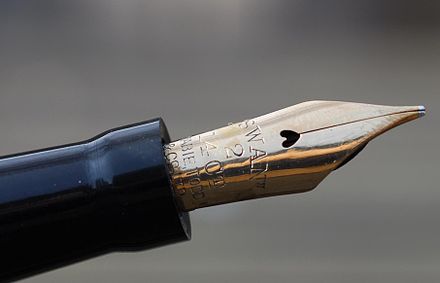Throwaway ballpoint pens pose a serious environment problem. Billions are used and thrown away every year. These pens, and refills, are
not recycled since it is difficult to separate the metal nib and ink from the plastic.
It isn't a secret that the ballpoint pen is the most popular type of pen. It uses a thick, oil-based ink that is dissolved in alcohol. As soon as you write, the alcohol evaporates, and so the ink dries up quickly. The ink does not bleed through paper and lasts long. But since the ink is thicker, the pen must be pressed harder on paper leading to greater stress on the hand and slower writing.
Fountain Pen
An environment-friendly alternative to ballpoint pen is the fountain pen - it is commonly available too. Some kids may find it difficult to write with the traditional nib since its angle with the paper must remain the same to ensure smooth writing. To get around this, use fountain pens that have roller balls at the tip instead of nibs. (Ballpoint pens too use roller balls; however, the ink used by roller ball pens is thinner and so the flow is better.)
 |
| Fountain pen with nib (Wikipedia) |
Roller ball pens use either water-based ink or a thicker gel ink (pigments on a water-based gel). Gel ink dries quicker. It also writes thicker but may skip/slip occasionally and bleed more.
 |
Close-up shot of roller ball at the tip
(Wikipedia) |
Some pens use removable cartridges that hold ink - the advantage is that students can carry a spare cartridge to school instead of an ink pot. When the cartridge in the pen runs out of ink, it can be replaced with the spare one. The empty cartridge can be refilled later at home. Throwing away a cartridge after using it once defeats the purpose of using refillable ink pens. (Also, don't buy pens with cartridges that cannot be refilled.)
If you travel by air with a fountain pen, the guaranteed way to prevent leakage is to empty the ink tank. Or, fill it up and keep it upright. To use the pen, wait till the flight takes off and reaches 6000 feet, which is when cabin pressure is increased to match the pressure at ground level (the air trapped in the ink tank is at the pressure at ground level; if the pen is opened before the cabin is pressurized, the higher pressure of air in the tank will push out the ink since the pressure in the cabin would be lesser).



